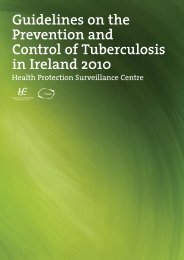Guidelines for the Early Clinical and Public Health Management of ...
Guidelines for the Early Clinical and Public Health Management of ...
Guidelines for the Early Clinical and Public Health Management of ...
Create successful ePaper yourself
Turn your PDF publications into a flip-book with our unique Google optimized e-Paper software.
<strong>Guidelines</strong> <strong>for</strong> <strong>the</strong> <strong>Early</strong> <strong>Clinical</strong> <strong>and</strong> <strong>Public</strong> <strong>Health</strong> <strong>Management</strong> <strong>of</strong> Bacterial Meningitis (including Meningococcal Disease)<br />
7.5 The public health response<br />
The public health response should be implemented as soon as possible, <strong>and</strong> includes <strong>the</strong> following actions:<br />
• Identification <strong>of</strong> close contacts.<br />
(The designated medical <strong>of</strong>ficers <strong>of</strong> health (MOH) under Infectious Disease Regulations 34 have <strong>the</strong> authority<br />
<strong>and</strong> obligation to “make such enquiries <strong>and</strong> take such steps as are necessary or desirable <strong>for</strong> investigating<br />
<strong>the</strong> nature <strong>and</strong> source <strong>of</strong> such infection, <strong>for</strong> preventing <strong>the</strong> spread <strong>of</strong> such infection <strong>and</strong> <strong>for</strong> removing<br />
conditions favourable to such infection”. Under <strong>the</strong>se same regulations, “a person who refuses to comply<br />
with a requirement or direction given or a request <strong>for</strong> in<strong>for</strong>mation made in pursuance <strong>of</strong> any <strong>of</strong> <strong>the</strong> provisions<br />
<strong>of</strong> <strong>the</strong>se Regulations shall be guilty <strong>of</strong> a contravention <strong>of</strong> <strong>the</strong>se Regulations”).<br />
• Arranging appropriate chemoprophylaxis to those identified as requiring prophylaxis.<br />
• Provision <strong>of</strong> appropriate in<strong>for</strong>mation.<br />
7.5.1 Dissemination <strong>of</strong> in<strong>for</strong>mation<br />
Following a case <strong>of</strong> meningococcal disease, it is important to give out in<strong>for</strong>mation because early diagnosis <strong>and</strong><br />
treatment should improve outcome. There is a small but real risk <strong>of</strong> fur<strong>the</strong>r linked cases. 46 Vigilance <strong>for</strong> signs <strong>and</strong><br />
symptoms among contacts is important especially in <strong>the</strong> immediate high risk period (one week) after onset <strong>of</strong><br />
symptoms in a case. Accurate <strong>and</strong> timely in<strong>for</strong>mation should help limit <strong>the</strong> spread <strong>of</strong> false rumours <strong>and</strong> anxiety <strong>and</strong><br />
to some extent allay public concern.<br />
In<strong>for</strong>mation should be sufficient to ensure awareness <strong>of</strong> <strong>the</strong> situation whiles preserving patient confidentiality.<br />
The family <strong>of</strong> a case should be in<strong>for</strong>med that in<strong>for</strong>mation will be distributed as appropriate. Leaflets or o<strong>the</strong>r printed<br />
material about meningococcal disease should be widely available <strong>and</strong> quickly distributed after reporting <strong>of</strong> a<br />
confirmed or clinical case. Examples <strong>of</strong> in<strong>for</strong>mation sheets can be found in <strong>the</strong> Appendix <strong>of</strong> <strong>the</strong>se guidelines.<br />
In<strong>for</strong>mation to those given chemoprophylaxis should include:<br />
• Symptoms <strong>and</strong> signs <strong>of</strong> <strong>the</strong> disease <strong>and</strong> <strong>the</strong> need to seek urgent medical advice should <strong>the</strong>y become unwell<br />
• Chemoprophylaxis does not exclude <strong>the</strong> possibility, although small, <strong>of</strong> a person developing meningococcal<br />
disease<br />
• There is no need <strong>for</strong> an asymptomatic person who is taking chemoprophylaxis to be ‘quarantined’ in any way<br />
Recipients should be given this in<strong>for</strong>mation at <strong>the</strong> time <strong>of</strong> receiving chemoprophylaxis. This in<strong>for</strong>mation is covered in<br />
<strong>the</strong> example sheets at <strong>the</strong> back <strong>of</strong> <strong>the</strong> document (see Appendix <strong>for</strong> examples).<br />
Consider <strong>the</strong> need to in<strong>for</strong>m o<strong>the</strong>r HSE colleagues, GPs <strong>and</strong> GP out-<strong>of</strong>-hours services about <strong>the</strong> case <strong>and</strong> what public<br />
health actions have been taken or are required.<br />
When a case occurs in a childcare facility <strong>the</strong> manager should be in<strong>for</strong>med. The in<strong>for</strong>mation should be sufficient<br />
to ensure that o<strong>the</strong>r parents are aware <strong>of</strong> <strong>the</strong> situation whilst preserving <strong>the</strong> confidentiality <strong>of</strong> <strong>the</strong> patient.<br />
Arrangements should be made to provide in<strong>for</strong>mation <strong>for</strong> all <strong>the</strong> parents <strong>and</strong>, if indicated, chemoprophylaxis <strong>for</strong><br />
those identified as close contacts.<br />
When a case occurs in a school or college <strong>the</strong> principal/head should be in<strong>for</strong>med. Arrangements should be made to<br />
provide in<strong>for</strong>mation <strong>for</strong> o<strong>the</strong>r parents/students. The in<strong>for</strong>mation should be sufficient to ensure that parents/students<br />
are aware <strong>of</strong> <strong>the</strong> situation whilst preserving <strong>the</strong> confidentiality <strong>of</strong> <strong>the</strong> patient.<br />
If a suspected case occurs in a childcare or educational facility <strong>and</strong> public health action is not immediately indicated<br />
(e.g. a case considered that diagnoses o<strong>the</strong>r than meningococcal disease are at least as likely) it may still be<br />
advisable to discuss <strong>the</strong> situation with <strong>the</strong> manager/head at an early stage. The manager/head will <strong>the</strong>n be in a<br />
good position to respond immediately to parental concerns.<br />
7.5.2 Vaccines<br />
Meningococcal serogroup C conjugate vaccine (MenC)<br />
Meningococcal serogroup C conjugate vaccine (MenC) was introduced into <strong>the</strong> Irish childhood immunisation<br />
programme in October 2000 <strong>and</strong> a catch-up programme was provided to all children <strong>and</strong> young adults up to <strong>the</strong><br />
age <strong>of</strong> 23 years. The vaccine confers high levels <strong>of</strong> serum bactericidal antibody <strong>and</strong> induces immunological memory<br />
in individuals from <strong>the</strong> age <strong>of</strong> two months. 60 Preliminary estimates <strong>of</strong> vaccine efficacy suggest that <strong>the</strong> vaccine is 88-<br />
96% effective against invasive meningococcal disease due to serogroup C infection. Protection declines over time<br />
especially when given under 1 year <strong>of</strong> age. 61<br />
-64-

















